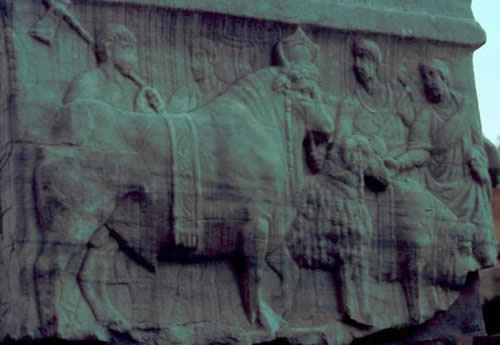The Suovetaurilia
by L.A. Curchin
Although many ancient cultures sacrificed animals to their gods, the Romans had a peculiar type of sacrifice called a suovetaurilia. This word is formed from the names of three animals, the pig (sus), sheep (ovis) and bull (taurus). In practice, the animals sacrificed seem to have all been male, so that the ‘sheep’ was actually a ram. Its curved horns are visible in many artistic representations of this ritual. (The word ovis, which is feminine in classical Latin, was originally applied to either gender.) Although the swine used in the suovetaurilia is often described in English as a ‘boar’, this does not mean a tusked wild boar, but rather an uncastrated male pig. All the animals in this sacrifice were, in fact, common farm livestock.The origin of the suovetaurilia appears to go back to early Indo-European times, because we find similar customs in Greece and India. The Greek ‘trittys’ was the sacrifice of a bull, a billy goat, and either a boar or a ram. India had the ‘sautramani’, the sacrifice of three animals to the protective god Indra. Indian custom allowed for a greater choice of sacrificial victims than at Rome. In descending order of importance, the animals that could be sacrificed in the sautramani were man, horse, ox, sheep and goat. Since human and horse sacrifice were relatively infrequent at Rome (see Labyrinth issue 80 on the ‘October Horse’), the three animals became regularized as boar, ram and bull.
The purpose of the suovetaurilia was lustratio (purification, from the verb luere ‘to loosen’). It was performed at certain state ceremonies, including agricultural festivals, the conclusion of a census, and to atone for any accidental ritual errors. If a temple was destroyed, the site had to be purified by the three-animal sacrifice before a new temple could be built. This happened, for instance, after the Capitolium was burnt in the civil war of AD 69. The suovetaurilia was also performed by the army as a lustration sacrifice to the war-god Mars before a military operation. A suovetaurilia is depicted, for instance, on Trajan’s Column, a monument commemorating the conquest of Dacia (modern Romania) at the beginning of the second century AD.

The monument illustrated here is the so-called Decennalia Base in the Roman Forum. It is the pedestal for one of four granite columns erected in AD 303 to commemorate the tenth anniversary of the Tetrarchy (the system of four emperors established by Diocletian). Each column bore a statue of one of the tetrarchs. The base is carved with four reliefs of victory and sacrifice, including a suovetaurilia. A boar, ram and bull are being led in the traditional order, while behind them stands the ‘victimarius’, the axe-bearing attendant who will slaughter the animals.
The commonest occurrence of the suovetaurilia was at the Ambarvalia (‘walking around fields’) festival every May. This was an agricultural festival intended to drive out evil from the fields and to purify the new crops, and the sacrifice was performed on every farm. The procedure for this lustration is described by Cato, Tibullus and Vergil. The farmer and his family had to wash themselves and wear white clothing and olive wreaths. No work could be done on this day, and no one who had had sex the night before could participate, because they were impure. The participants had to walk three times around the perimeter of their fields, leading a boar, ram and bull. This process of encircling the crops created a magical boundary to insulate them from harm. The magic number three is reflected both in the number of animals and the number of times you walked around the farm. These animals were then sacrificed, with prayers to the gods to protect the crops, livestock and farmers. Killing animals to protect your farm seems bizarre to us, but animal sacrifice was a normal accompaniment of prayer in Roman ritual. The guiding principle seems to have been: the family that prays together, slays together. After the animals were slain, their entrails, especially the liver, were examined for omens. If any of the three animals had imperfect internal organs, another must be sacrificed, until a satisfactory victim was found. The entrails and bones, wrapped in fat, were burnt on a stone altar to appease the gods. The edible meat would be cooked, and the participants in the ceremony would enjoy the resulting banquet of pork, mutton and beef.